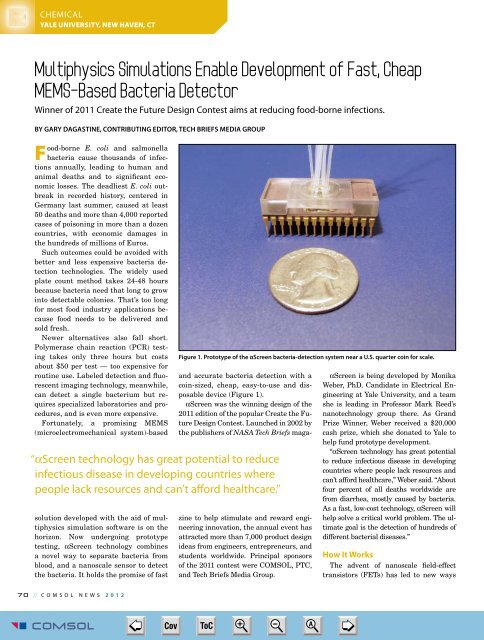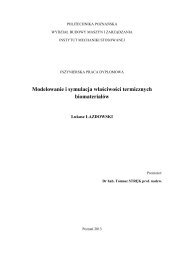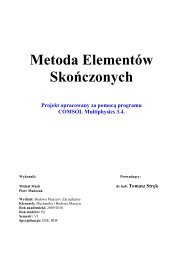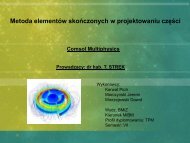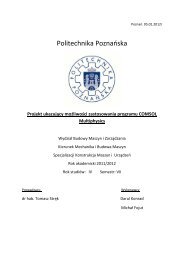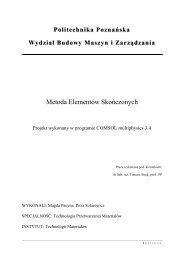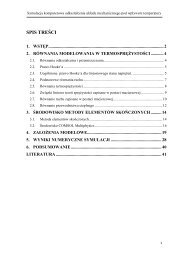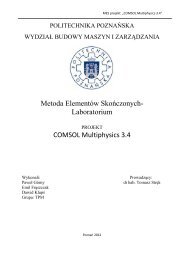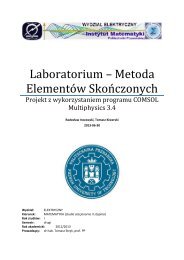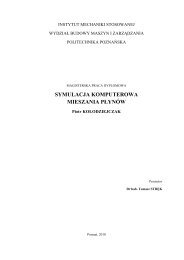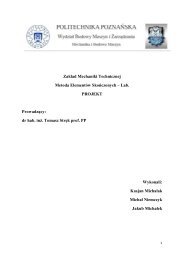COMSOL News
COMSOL News
COMSOL News
You also want an ePaper? Increase the reach of your titles
YUMPU automatically turns print PDFs into web optimized ePapers that Google loves.
CHEMICAL<br />
YALE UNIVERSITY, NEW HAVEN, CT<br />
Multiphysics Simulations Enable Development of Fast, Cheap<br />
MEMS-Based Bacteria Detector<br />
Winner of 2011 Create the Future Design Contest aims at reducing food-borne infections.<br />
BY GARY DAGASTINE, CONTRIBUTING EDITOR, TECH BRIEFS MEDIA GROUP<br />
Food-borne E. coli and salmonella<br />
bacteria cause thousands of infections<br />
annually, leading to human and<br />
animal deaths and to significant economic<br />
losses. The deadliest E. coli outbreak<br />
in recorded history, centered in<br />
Germany last summer, caused at least<br />
50 deaths and more than 4,000 reported<br />
cases of poisoning in more than a dozen<br />
countries, with economic damages in<br />
the hundreds of millions of Euros.<br />
Such outcomes could be avoided with<br />
better and less expensive bacteria detection<br />
technologies. The widely used<br />
plate count method takes 24-48 hours<br />
because bacteria need that long to grow<br />
into detectable colonies. That’s too long<br />
for most food industry applications because<br />
food needs to be delivered and<br />
sold fresh.<br />
Newer alternatives also fall short.<br />
Polymerase chain reaction (PCR) testing<br />
takes only three hours but costs<br />
about $50 per test — too expensive for<br />
routine use. Labeled detection and fluorescent<br />
imaging technology, meanwhile,<br />
can detect a single bacterium but requires<br />
specialized laboratories and procedures,<br />
and is even more expensive.<br />
Fortunately, a promising MEMS<br />
(microelectromechanical system)-based<br />
solution developed with the aid of multiphysics<br />
simulation software is on the<br />
horizon. Now undergoing prototype<br />
testing, αScreen technology combines<br />
a novel way to separate bacteria from<br />
blood, and a nanoscale sensor to detect<br />
the bacteria. It holds the promise of fast<br />
“ αScreen technology has great potential to reduce<br />
infectious disease in developing countries where<br />
people lack resources and can’t afford healthcare.”<br />
Figure 1. Prototype of the αScreen bacteria-detection system near a U.S. quarter coin for scale.<br />
and accurate bacteria detection with a<br />
coin-sized, cheap, easy-to-use and disposable<br />
device (Figure 1).<br />
αScreen was the winning design of the<br />
2011 edition of the popular Create the Future<br />
Design Contest. Launched in 2002 by<br />
the publishers of NASA Tech Briefs magazine<br />
to help stimulate and reward engineering<br />
innovation, the annual event has<br />
attracted more than 7,000 product design<br />
ideas from engineers, entrepreneurs, and<br />
students worldwide. Principal sponsors<br />
of the 2011 contest were <strong>COMSOL</strong>, PTC,<br />
and Tech Briefs Media Group.<br />
αScreen is being developed by Monika<br />
Weber, PhD. Candidate in Electrical Engineering<br />
at Yale University, and a team<br />
she is leading in Professor Mark Reed’s<br />
nanotechnology group there. As Grand<br />
Prize Winner, Weber received a $20,000<br />
cash prize, which she donated to Yale to<br />
help fund prototype development.<br />
“αScreen technology has great potential<br />
to reduce infectious disease in developing<br />
countries where people lack resources and<br />
can’t afford healthcare,” Weber said. “About<br />
four percent of all deaths worldwide are<br />
from diarrhea, mostly caused by bacteria.<br />
As a fast, low-cost technology, αScreen will<br />
help solve a critical world problem. The ultimate<br />
goal is the detection of hundreds of<br />
different bacterial diseases.”<br />
How It Works<br />
The advent of nanoscale field-effect<br />
transistors (FETs) has led to new ways<br />
7 0 // <strong>COMSOL</strong> NEWS 2 0 1 2<br />
<strong>COMSOL</strong> <strong>News</strong> 2012-17.indd 70<br />
➮<br />
Cov ToC + – A<br />
➭<br />
5/15/12 3:01 PM


